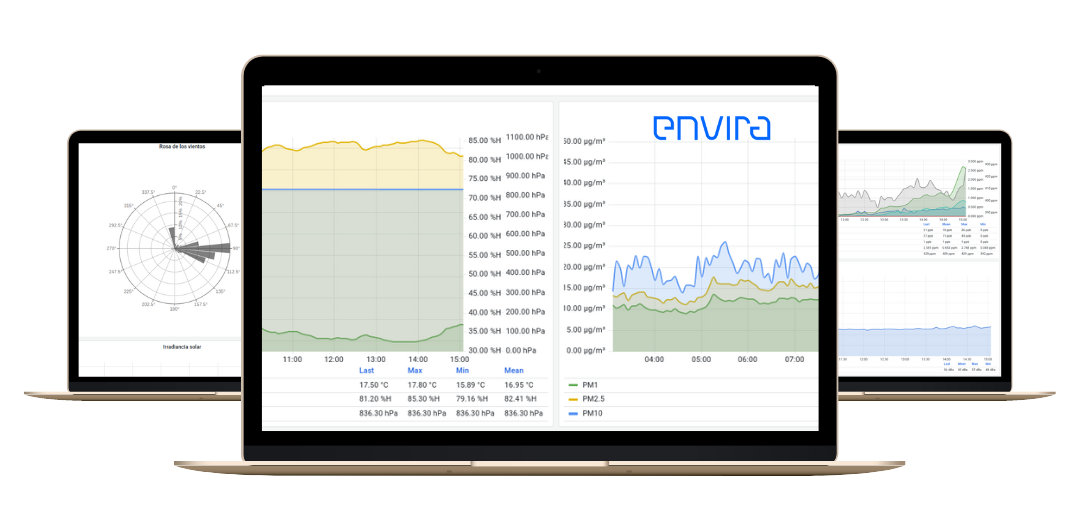Malaga joins the list of cities that have already defined their Low Emission Zone and have begun to take the first steps towards its effective implementation.
As part of the Plan for the Recovery, Transformation and Resilience of the Economy, Malaga City Council has contracted Envira for the design, supply, installation and commissioning of the network for monitoring and control of air quality and noise levels associated with the low emission zone.
The project consisted of the design, manufacture, installation and maintenance of 8 air quality and noise level control stations, monitoring the following parameters:
- Nitrogen Oxides (NOx)
- Carbon monoxide (CO)
- Particulate matter PM10 and PM 2.5
- Meteorological parameters (Pressure, Temperature, Wind Speed and Direction)
- Noise level
It also includes the acquisition of data, the operation and maintenance of the network and the creation of a website to provide information to the public.
These stations will be located at strategic points within the Malaga LEZ and on its borders.
In this way it will be possible to assess the impact of the LEZ on air quality and noise levels both within the LEZ itself and in the surrounding area, as the restrictions will lead to changes in the density and behaviour of traffic flows.
Design of the air quality monitoring and control network in the Malaga LEZ
It is very important to have a clear picture of the most polluted points, both in terms of air quality and noise pollution, in order to define the locations of the monitoring stations, as required by RD 1052/2022.
The precise identification of these points is a challenge, as it first requires measurement campaigns to be carried out in different parts of the city in order to reliably and accurately identify the areas most affected by pollution.
In this case, the measuring stations commonly used in air quality networks are less suitable due to their large size, as they are located in the city centre.

Mobile Air Quality Monitoring Unit and Portable EMAC Units
In order to determine the possible final locations, a strategy of spot measurements is proposed in different parts of the city, using the Mobile Air Quality Monitoring Unit and portable EMAC units, with the aim of obtaining data and a picture of the situation before the LEZ is implemented.
This, together with the historical information available from Malaga City Council and the Regional Government of Andalusia on the state of air quality in the municipality and the information available in the strategic noise maps, provides a first approximation of the possible locations of the stations that will make up the monitoring and control network.
Less visual impact
One of the requirements of the Malaga City Council in relation to the Low Emission Zone (LEZ) is that the monitoring stations (in addition to the other requirements) should have a minimum visual impact, since they will be located in different parts of the city, including tourist areas and close to the historic centre.
This requirement is not without its difficulties, as the solutions currently available on the market have standard dimensions, including the fencing to protect the equipment.

Design of compact air quality monitoring stations
To meet this requirement, Compact Air Quality Measurement Stations have been specially designed with smaller than usual dimensions.
These compact and lightweight stations are also easier to move.
Instead of the usual perimeter fencing, a special system was developed to protect the sampling points of the equipment, which in turn helps to reduce the overall dimensions.
Data collection, validation and diffusion
In order to support the implementation of the Malaga 2023 Low Emission Zone and to measure the effectiveness of the measures, the City Council requests monthly reports on the evolution of air quality and noise pollution, indicating compliance with the values and the monitoring of the indicators.
This information will be used by the City Council to support the updating of the levels of the Municipal Air Quality Plan and other plans and initiatives.

Software Platform
Envira’s solution is a multi-functional software that serves as a basis for municipal staff to understand, use and make decisions based on air quality and noise data.
The data collected in real time by the various instruments can be exported in standard formats for communication and connection with other authorities.

This software allows the management of reports, graphical visualisation and validation of data acquired in accordance with air quality and noise regulations, as well as monitoring indicators in accordance with RD 102/2011.
Conclusion: The Malaga LEZ, in line with the objectives of RD 1052/2022
Málaga City Council has awarded Envira the contract for the design, supply, installation and commissioning of the air quality and noise monitoring and control network for the Low Emission Zone.
As a result, Envira is responsible for implementing the project with 8 monitoring stations located in key areas, with reference equipment that complies with current regulations on air quality, noise and the LEZ.










